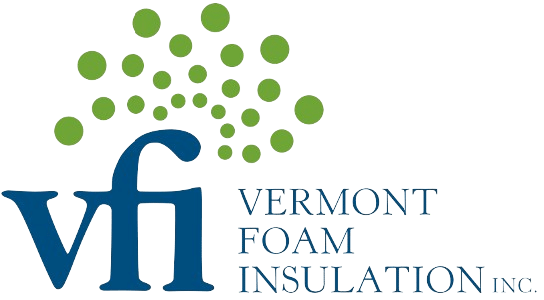Winter in Vermont often recalls images of quaint Cape Cod style homes with a soft blanket of snow on the roof and crystal-like icicles hanging from the gutters. It’s a picturesque scene, to be sure, but did you know those icicles could actually be bad news for your home?
That’s because ice dams and icicles are usually a sign of an under-insulated attic. Learn more about the potential hazards of icicles and ice dams — and why you should improve your attic if you see them on your roof this winter.
How Ice Dams & Icicles Form
Ice dams and icicles need three things to form: snow, heat from the attic, and cold weather. Ice dam formation starts when snow accumulates on the roof and heat from the attic warms the surface of the roof. As long as the surface of the roof is warmer than 32 degrees F, the snow on the roof will melt and flow down to the edge of the roof. Despite the snow melting, if outside temperature is still cold (below 32 degrees), the water will re-freeze at edge of the roof. This initially creates icicles and over time can form a thick layer of ice along the edge of the roof. Eventually the layer of ice can build thick enough to create a dam.
Why Worry About Ice Dams?
Ice dams and heavy icicles have the potential to cause serious damage to your gutters, siding, roof, and attic. When left unchecked, for example, an ice dam could prevent additional melted snow from flowing off the roof, forcing that melted snow to leak into the attic. This, in turn, can lead to moisture issues, mold growth, damaged insulation, and structural damage.
Ice Dam Prevention Starts in the Attic
It isn’t always easy to get rid of ice dams once they form, but, conceptually, it is easy to prevent them. With the right attic upgrades, you can keep heat out of the attic and reduce or even stop icicles and ice dams from forming in the first place. Plus, you’ll gain access to other benefits like greater home efficiency and lower energy bills.
First: Air Sealing
The first step to keeping heat out of the attic is to have a professional insulation contractor seal air leaks. These air leaks are often found around the attic hatch, recessed lighting, interior wall partitions, and wire penetrations. The team at Vermont Foam Insulation uses high performance spray foam to completely seal these air leaks. Sometimes the first step to finding air leaks is actually removing the old insulation entirely from the attic floor. Doing so ensures a job well done.
Second: Attic Floor Insulation
After air sealing the attic floor, the next step is to upgrade the insulation in the attic. Our team installs loose fill cellulose insulation along the attic floor to reduce heat loss as a result of conduction. Adding a thick layer of insulation onto the attic floor will increase the rvalue to at least minimum code requirements.
The best thing about these upgrades? In addition to preventing ice dams, they will reduce heat loss through the attic — meaning you won’t have to run your heating system as often to keep your home comfortable. That, in turn, means greater home energy efficiency and lower energy bills.








